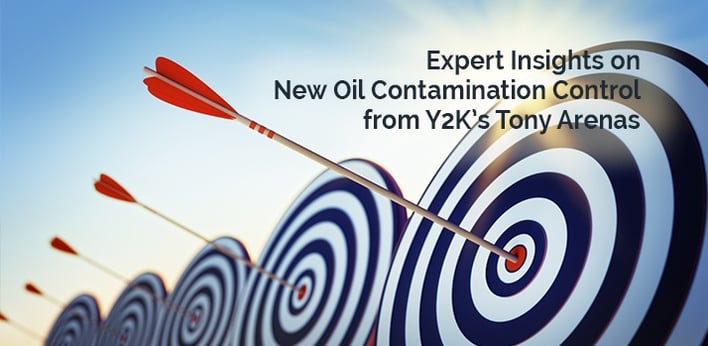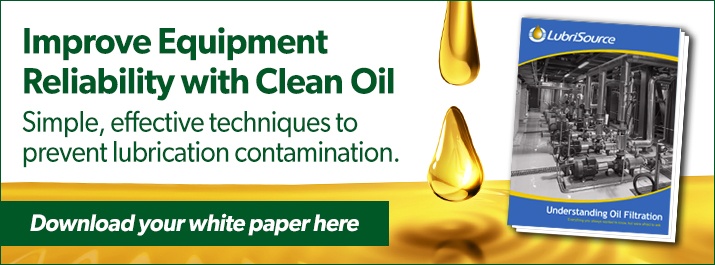
“New” doesn’t necessarily equate to “clean” when it comes to industrial oils and lubricants. Even though they may look pure, new oils require special care and handling to detect and avoid contamination.
We talked to Tony Arenas, Operations Manager at Y2K Fluid Power, about new oil practices. Tony gave the type of deeply detailed insights and tips that can only come from extensive professional experience and knowledge. Y2K designs and manufactures a complete line of filtration and fluid conditioning products for removing liquid and solid particulate contamination in hydraulic and lubricating oil systems.
First and foremost, Tony says, “Always monitor the condition of your oil and use best practices. It is the lifeblood of any hydraulic and lubricating system and has a huge impact on the sustainability, reliability and longevity of the equipment or machine it is used in.”
What does “clean” mean for new oils? How do you set an appropriate cleanliness target?
In relation to new oils, “clean” is a relative term based on your system and application. There is no single target to shoot for with new oils. It depends on the application, components, and equipment where the oil will be used.
For example, it would not be as much of a concern to have new oil, which is typically at an ISO cleanliness of 21/20/19, on a ram pump or flow control valve as it would be on a servo valve with tight tolerances between spools that has a manufacturer’s suggested ISO cleanliness level of 16/14/11.
Here are 5 questions and 3 steps we use to determine the correct level of filtration needed for a particular system:
5 Questions and 3 Steps to Ensure Cleanliness Target Success
5 Questions
- Application Information?
- Oil Type & Viscosity?
- Temperature of the Oil to be Filtered?
- Reservoir or Sump Size?
- ISO Cleanliness Requirement?
3 Steps
- Define targets for particle and water contamination and oil properties.
- Investigate remedial action as necessary to reach targets.
- Monitor contamination levels against target levels and maintain safe levels.
In any case, the most critical system component that has the potential of causing system failure will be the sole contributor for setting the ISO cleanliness level of a particular system, and most manufacturers will have a suggested ISO cleanliness level for any particular component supplied.
Why is it necessary to go beyond visual inspection of new oils?
First, I’d like to address the term “new oil” which is sometimes referenced as “clean oil.” Because new oil appears translucent and clear, the assumption is that it is also “clean” and safe for your system. The fact is, the human eye can see only approximately 40 micron or higher particles at best. Most advanced filtration systems remove particles in the range of 3-25 microns - well under the limitations of the human eye.
Therefore, it is recommended to standardize your oil cleanliness levels based on your specific application and verify this through an inline particle monitor and/or certified oil analysis lab to confirm the ISO standard contamination level in your system. In addition to contamination, moisture content and additives can be verified through an oil analysis, which may present problems in your system and cannot be detected by visually inspecting the oil. This is a best practice for new oils and any good reliability program.
What are the best practices to avoid contamination while transferring oil?
We always urge people to strive for contaminant exclusion by utilizing best practice procedures, a closed loop oil filtration system, and commonsense. Ensuring the fluid you’re transferring meets the required ISO cleanliness level before it is introduced into a system will eliminate added contamination and costs during transfers.
Best Practice Tips:
-
Desiccant breathers on tanks keep moisture out.
-
Ensure all tank ports or openings are sealed completely.
-
Utilizing closed loop oil handling/filtration ensures that no added
contamination is introduced into your system. -
A process for handling, filtering and transferring new or bulk oils
greatly reduces contamination levels in your systems.
What features should buyers look for in a filtration unit and a filter cart? What factors should go into their considerations?
The Evolution
More organizations are placing a greater emphasis on equipment reliability and better lubrication practices. They realize how valuable a filter cart can be in helping achieve best practice goals. As practices have changed over the years, filter carts have evolved from being used only on critical equipment to being a staple in every engineer’s lube room. However, a lack of knowledge regarding how to select the right filter cart, from both the customer and the distributor, can cause several costly mistakes.
The following are aspects to take into consideration to help eliminate costly mistakes and obtain maximum value for your investment.
Intended Use
The filter cart isn’t just for offline filtration anymore. Now more than ever, it’s being used for dispensing new oil, performing routine oil changes, and flushing new components. Before selecting your filter cart, you should consider factors such as size and weight. Ideally, your filter cart should easily reach each system you’re trying to clean. If the size and weight of the cart make it too cumbersome to use or too difficult for operators to maneuver to the desired location, you might want to consider alternative options.
Power Source
Many carts are offered with various power sources. Most suppliers offer 110/220V, single and three-phase motors as well as various air motor options. Speak with your supplier to make sure the power source you need or have access to in your plant is available.
Flow Rate
This is usually the most complex of all your selections because there is no “one size fits all” when it comes to determining the appropriate pump to use. Not all pumps are equal. There should be careful thought put into this decision.
Before making a selection, consider all the various applications you plan to use your cart for, such as fluid viscosity, oil temperature, time and fluid compatibility. A pump designed for ISO 32 hydraulic oil will not perform acceptably for an ISO 680 gear oil. The maximum pump flow rate should be at least 10 percent of the total pump volume. A 10-gallon reservoir requires no more than one GPM for completed fluid turnover. Insufficient flow results in long turnover times. At a minimum, the pump you select should be able to turn over the entire pump capacity at least one time per hour.
Filter Type
Before you choose a specific filter element, you must first determine the desired ISO cleanliness code you’d like to achieve. Always select filters with a micron rating at least as small as the particle size you are interested in filtering. Most quality filter carts utilize dual elements that run in a series. Often, either a water removal element or larger micron element is used as the first filter. Then, a finer micron filter element, or polishing element, is used second in the series. This helps extend the life of the smaller micron element and maximizes filter efficiency.
Another consideration is the beta rating of the elements you select. The higher the beta rating, the more efficient the filter element will be. You should always make sure that the element chosen is going to meet the cleanliness level required for the system.
Do you recommend a standard process be taken when new oils arrive?
Always have a good process for handling fluids. Whether new oil arrives in bulk, drums or some other means, the process should remain the same: New oil should always be pre-filtered to ensure it meets the specifications of the equipment or machine where it will be used. Proper handling and filtering of new oil ensures system reliability which can drastically decrease the maintenance costs of failures, not to mention lost revenue due to downtime.








